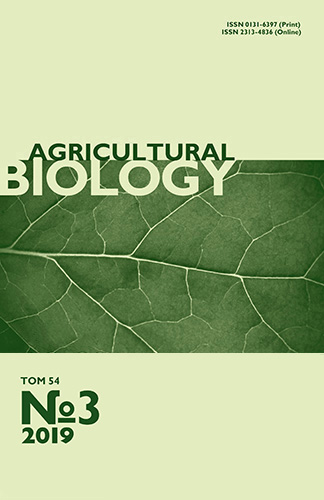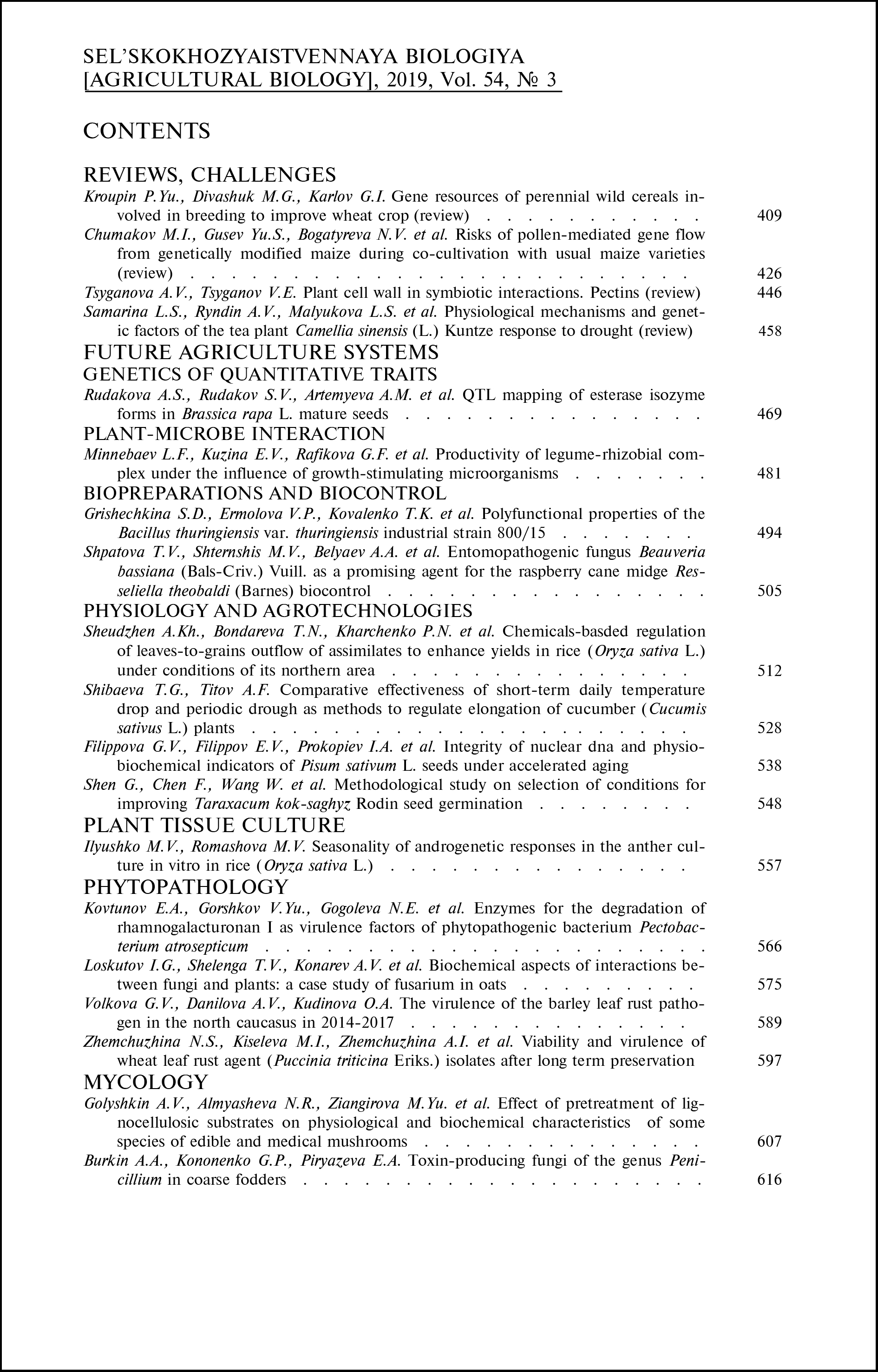doi: 10.15389/agrobiology.2019.3.575eng
UDC: 633.13:632.4:581.19
Acknowledgements:
The authors express their sincere gratitude to T.Yu. Gagkayeva and O.P. Gavrilova (All-Russian Research Institute of Plant Protection, St. Petersburg) for providing data on plant resistance to Fusarium and mycotoxin accumulation in grain.
Supported financially by Russian Science Foundation, project No. 14-16-00072
BIOCHEMICAL ASPECTS OF INTERACTIONS BETWEEN FUNGI AND PLANTS: A CASE STUDY OF FUSARIUM IN OATS
I.G. Loskutov1, 2, T.V. Shelenga1, A.V. Konarev1, V.I. Horeva1,
A.L. Shavarda2, 3, E.V. Blinova1, A.A. Gnutikov1
1Federal Research Center Vavilov All-Russian Institute of Plant Genetic Resources, 42-44, ul. Bol’shaya Morskaya, St. Petersburg, 190000 Russia, e-mail i.loskutov@vir.nw.ru (✉ corresponding author), t.shelenga@vir.nw.ru, a.konarev@vir.nw.ru, horeva43@mail.ru, e.blinova@vir.nw.ru, alexandr2911@yandex.ru;
2Saint-Petersburg State Agrarian University, 2, Peterburgskoe sh., St. Petersburg—Pushkin, 196601 Russia;
3Komarov Botanical Institute RAS, 2, ul. Professora Popova, St. Petersburg, 197376 Russia, e-mail: stachyopsis@gmail.com
ORCID:
Loskutov I.G. orcid.org/0000-0002-9250-7225
Shavarda A.L. orcid.org/0000-0003-1778-2814
Shelenga T.V. orcid.org/0000-0003-3992-5353
Blinova E.V. orcid.org/0000-0002-8898-4926
Konarev A.V. orcid.org/0000-0003-2938-1014
Gnutikov A.A. orcid.org/0000-0002-5264-5594
Horeva V.I. orcid.org/0000-0003-2762-2777
Received September 20, 2018
Disclosing the mechanisms that build up plant resistance to fungal diseases (pathogenic microorganisms) invariably evokes the need to analyze biochemical factors of resistance. Protective mechanisms are associated with a fairly large number of chemical compounds. Fusarium head blight (FHB) affects cereal grains, including wheat, barley and oats. In this work, we report new data on the metabolic profile of oat grains, as influenced by FHB, and a relationship between plant resistance and content of individual metabolites in FHB-susceptible and FHB-resistant varieties. Here, we have challenged the task to assess the connections of FHB-resistance parameters in oat varieties with as many compounds as possible. Such data are required both to understand the mechanisms of resistance and to develop methods for its assessment. Common oat (Avena sativa L.) varieties from the collection of the Vavilov Institute (VIR) were studied to evaluate their numerous biochemical characters and their resistance to FHB. The fatty acid composition of oil was analyzed by the method of gas-liquid chromatography with mass spectrometry on an Agilent 6850 chromatographer (USA), and other metabolites were quantitated. Plant resistance was studied under artificial infestation of ears with F. culmorum and F. sporotrichioides (an experimental field, All-Russian Research Institute for Plant Protection, St. Petersburg—Pushkin, 2015). Fusarium Link fungi DNA content and trichothecene mycotoxins were determined in milled grain samples. The amount of DNA of Fusarium fungi was measured by real-time PCR techniques using Tri5 gene-based group-specific primers. Solid-phase competitive enzyme-linked immunosorbent assay (ELISA) was used to measure the content of T-2 toxin and DON in grain. The statistical significance of differences in biochemical parameters, including metabolic profiles, between resistant and susceptible oat varieties was estimated with the Mann-Whitney criterion. For the first time, correlations were found between Fusarium resistance and biochemical characteristics of oat. It has been shown that high-protein forms are less affected by FHB, accumulate less toxins, and are more adaptive to biotic stress. Plant resistance to FHB correlates with accumulation of pipecolic acid, monoacylglycegols, tyrosine, galactinol, a number of phytosterols, sugars and adenosine. The values of such correlations and connections between chemical compounds and various parameters of Fusarium resistance identified during the study of oat accessions should be regarded as strictly preliminary, since they are the outcome of only one year of field trials. However, the year in consideration was characterized by extremely favorable conditions for the development of parasitic Fusarium fungi with all immanent consequences. An assumption can be made that the increased aggressiveness of the latter (kind of a model condition) allowed us to identify with more reliability the connections between a majority of metabolite content and composition parameters and the level of Fusarium resistance. Considering the complex polygenic nature of the control over the character “resistance to Fusarium head blight” and, therefore, strong dependence of its expression on the environments, any future efforts to confirm (or refute) our conclusions will require researching greater intra- and interspecies diversity of this crop’s accessions reproduced in various environments and in different years.
Keywords: Avena sativa L., oat, varieties, Fusarium head blight, Fusarium, fungal DNA, PCR, mycotoxins, gas chromatography, mass spectrometry, biochemistry, metabolomics.
REFERENCES
- Loskutov I.G. Oves (Avena L.). Rasprostranenie, sistematika, evolyutsiya i selektsionnaya tsennost' [Oats (Avena L.). Distribution, taxonomy, evolution and breeding value]. St. Petersburg, 2007 (in Russ.).
- Baum B.R. Oats: wild and cultivated. A monograph of the genus Avena L. (Poaceae). Monogr. No. 14. Ottava, Canada, 1977.
- Gagkaeva T.Yu., Gavrilova O.P., Levitin M.M., Novozhilov K.V. Prilozhenie k zhurnalu «Zashchita i karantin rastenii», 2011, 5: 70-82 (in Russ.).
- Chakraborty S., Newton A.C. Climate change, plant diseases and food security: an overview. Plant Pathology, 2011, 60(1): 1-14 CrossRef
- Pestka J. Deoxynivalenol: mechanisms of action, human exposure, and toxicological relevance. Archives of Toxicology, 2010, 84(9): 663-679 CrossRef
- Gagkaeva T.Yu., Gavrilova O.P., Levitin M.M. Bioraznoobrazie i arealy osnovnykh toksinoprodutsiruyushchikh gribov roda Fusarium. Biosfera, 2014, 6(1): 36-45 (in Russ.).
- Fiehn O., Kopka J., Dörmann P., Altmann T., Trethewey R.N., Willmitzer L. Metabolite profiling for plant functional genomics. Nature Biotechnology, 2000, 18(11): 1157-1161 CrossRef
- Hill C. B., Roessner U. Metabolic profiling of plants by GC–MS. In: The handbook of plant metabolomics /W. Weckwerth, G. Kahl (eds.). Weinheim, Germany: Wiley-VCH Verlag GmbH & Co. KGaA, 2013: 1-23.
- Loskutov I.G., Shelenga T.V., Konarev A.V., Shavarda A.L., Blinova E.V., Dzyubenko N.I. Vavilovskii zhurnal genetiki i selektsii, 2016, 20(5): 642-648 CrossRef
- Choo T.M. Breeding barley for resistance to Fusarium head blight and mycotoxin accumulation. Plant Breeding Reviews, 2006, 26: 125-169 CrossRef
- Buerstmayr H., Ban T., Anderson J.A. QTL mapping and marker-assisted selection for Fusarium head blight resistance in wheat: a review. Plant Breeding,2009, 128(1): 1-26 CrossRef
- Lemmens M., Scholz U., Berthiller F., Dall’Asta C., Koutnik A., Schuhmacher R., Adam G., Buerstmayr H., Mesterházy Á., Krska R., Ruckenbauer P. The ability to detoxify the mycotoxin deoxynivalenol colocalizes with a major quantitative trait locus for Fusarium head blight resistance in wheat. Molecular Plant-Microbe Interactions,2005, 18(12): 1318-1324 CrossRef
- D'yakov Yu.T., Tikhonovich I.A., Shcherbakova L.A., Ozeretskovskaya O.L., Dzhavakhiya V.G., Provorov N.A., Bagirova S.F. Fundamental'naya fitopatologiya /Pod redaktsiei Yu.T. D'yakova [Fundamental phytopathology. Yu.T. D'yakov (ed.)]. Moscow, 2012 (in Russ.).
- Bushnell W.R., Perkins-Veazie P., Russo V.M., Collins J., Seeland T.M. Effects of deoxynivalenol on content of chloroplast pigments in barley leaf tissues. Phytopathology, 2009, 100(1), 33-41 CrossRef
- Bolton M.D. Current review: Primary metabolism and plant defense — fuel for the fire. Molecular Plant-Microbe Interactions, 2009, 22(5), 487-497 CrossRef
- Warth B., Parich A., Bueschl C., Schoefbeck D., Katharina N., Neumann N., Kluger B., Schuster K., Krska R., Adam G., Lemmens M., Schuhmacher R. GC—MS based targeted metabolic profiling identifies changes in the wheat metabolome following deoxynivalenol treatment. Metabolomics, 2015, 11(3): 722-738 CrossRef
- Sitkin S.I., Tkachenko E.I., Vakhitov T.Ya., Oreshko L.S., Zhigalova T.N. Eksperimental'naya gastroentoroskopiya, 2013, 12:77-90 ).
- Loskutov I.G., Kovaleva O.N., Blinova E.V. Metodicheskie ukazaniya po izucheniyu i sokhraneniyu mirovoi kollektsii yachmenya i ovsa [Study and preservation of the world collection of barley and oats: Guidelines]. St. Petersburg, 2012 (in Russ.).
- Oat Descriptors. IBPGR, Rome, 1985.
- Metody biokhimicheskogo issledovaniya rastenii /Pod redaktsiei A.I. Ermakova [Methods of plant biochemistry. A.I. Ermakov (ed.)]. Leningrad, 1987 ).
- Halstensen A.S., Nordby K.C., Eduard W., Klemsdal S.S. Real-time PCR detection of toxigenic Fusarium in airborne and settled grain dust and associations with trichothecene mycotoxins. Journal of Environmental Monitoring, 2006, 8(12): 1235-1241 CrossRef
- Yli-Mattila T., Paavanen-Huhtala S., Jestoi M., Parikka P., Hietaniemi V., Gagkaeva T., Sarlin T., Haikara A., Laaksonen S., Rizzo A. Real-time PCR detection and quantification of Fusarium poae, F. graminearum, F. sporotrichioides and F. langsethiae in cereal grains in Finland and Russia. Archives of Phytopathology and Plant Protection, 2008, 41(4): 243-260 CrossRef
- European commission. Community reference laboratory for GM food and feed. Event-specific for the quantitation of maize line NK603 using real-time PCR. 2005. Available http://gmo-crl.jrc.ec.europa.eu/summaries/NK603report_mm.pdf. No date.
- Gagkaeva T.Yu., Gavrilova O.P., Orina A.S., Blinova E.V., Loskutov I.G. Diversity of Avena species by morphological traits and resistance to Fusarium head blight. Russian Journal of Genetics: Applied Research, 2018, 8(1): 44-51 CrossRef
- Perkowski J., Stuper K., Busko M., Goral T., Kaczmarek A., Jelen H. Differences in metabolomic profiles of the naturals contaminated grain of barley, oats and rye. Journal of Cereal Science, 2012, 56: 544-551 CrossRef
- Nussbaumer T., Warth B., Sharma S., Ametz C., Bueschl C., Parich A., Pfeifer M., Siegwart G., Steiner B., Lemmens M., Schuhmacher R., Buerstmayr H., Mayer K.F.X., Kugler K.G., Schweiger W. Joint transcriptomic and metabolomic analyses reveal changes in the primary metabolism and imbalances in the subgenome orchestration in the bread wheat molecular response to Fusarium graminearum. Genes, Genomes, Genetics, 2015, 5(12): 2579-2592 CrossRef
- Konarev A.V., Shelenga T.V., Perchuk I.N., Blinova E.V., Loskutov I.G. Agrarnaya Rossiya, 2015, 5: 2-10 (in Russ.).
- Balmer D., Flors V. , Glauser G., Mauch-Mani B. Metabolomics of cereals under biotic stress: current knowledge and techniques. Front. Plant Sci., 2013, 4(82): 1-12 CrossRef
- Heuberger A.L., Robison F.M., Lyons S.M.A., Broeckling C.D., Prenni J.E. Evaluating plant immunity using mass spectrometry-based metabolomics workflows. Front. Plant Sci., 2014, 5(291): 1-11 CrossRef
- Hollywood K., Brison D.R., Goodacre R. Metabolomics: current technologies and future trends. Proteomics, 2006, 6(17): 4716-4723 CrossRef
- Zilić S., Hadzi-Tasković Sukalović V., Dodig D., Maksimović V., Maksimović M., Basić Z. Antioxidant activity of small grain cereals caused by phenolics and lipid soluble antioxidants. Journal of Cereal Science, 2011, 54(3): 417-424 CrossRef
- Semikhov V.F., Aref'eva L.P., Novozhilova O.A. Fiziologiya rastenii, 2000, 3: 303-321 (in Russ.).
- Allard R.W. Genetic basis of the evolution of adaptedness in plants. In: Adaptation in plant breeding. P.M.A. Tigerstedt (ed.). Kluwer Academic Publishers, 1996: 1-11.
- Schauer N., Fernie A.R. Plant metabolomics: towards biological functions and mechanism. Trends Plant Sci., 2006, 11(10): 508-516 CrossRef
- Kluger B., Bueschl C., Lemmens M., Michlmayr H., Malachova A., Koutnik A., Maloku I., Berthiller F., Adam G., Krska R., Schuhmacher R.Biotransformation of the mycotoxin deoxynivalenol in Fusarium resistant and susceptible near isogenic wheat lines. PLoS ONE,2015, 10(3): e0119656 CrossRef












